The most suitable infant formula is prescribed by a pediatrician, but parents also need to know some simple rules her choice.
Up to 6 months, only adapted substitutes are acceptable for a baby: in their protein, fat and carbohydrate composition, they are as close as possible to women's milk and are enriched with all the vitamins and minerals necessary for an infant. All initial mixes are adapted. The energy value of the subsequent mixtures is higher - they increase the content of protein, iron and other important nutrients. A number of mixtures that contain the average amount of all the nutrients necessary for a child in the first year of life can be called universal. They can be used for feeding children from birth to one year.
Mixes for baby food
For feeding children of the first year of life, they use dry and liquid (ready-to-eat), fresh and fermented milk substitutes for breast milk. Most of the mixes are made on the basis of cow's milk that has undergone special processing. In order to reduce the likelihood of allergies, the mixture is approximated by chemical composition to breast milk. Depending on the chemical composition of breast milk and other parameters, they are divided into several types: adapted mixtures, non-adapted mixtures, and special (therapeutic) mixtures.
Adapted blends
To approximate the composition of cow's milk to breast milk, they change the quantitative and qualitative composition with the help of special technologies. To this end, carry out:
- The decrease in total protein, the ratio of different protein fractions (albumin and caseins).
- Milk fortification with polyunsaturated fatty acids, carbohydrates (lactose).
- The increase in the content of vitamins and trace elements (iron), the additional introduction of biologically active substances (taurine).
- The introduction of additional components (carob gluten, starch) to obtain mixtures for children with special dietary needs.
Adapted mixtures are more close to the composition. breast milk for all components. Proteins are represented mainly by whey proteins: they are easier absorbed by the body of a small child. Calcium and phosphorus - the substances necessary for the mineralization of bone tissue - are contained in the optimal ratio. The majority of the mixtures include taurine, contained in breast milk and absent in cow's milk. It is a free amino acid that has a positive effect on the digestion and absorption of fats in the digestive tract of a baby, and is necessary for the development of the retina and brain. This amino acid is indispensable for children of the first months of life, especially premature.
Nucleotides, important biologically active substances that contribute to the maturation of the infant’s tissues and the formation of its immune system, and have a positive effect on the digestive processes, have been introduced into the adapted milk formulas of the new generation. Such mixtures are designed for weakened, often ill children. The mixture also includes a set of vitamins necessary for children in the first months of life (vitamins A, E, C, D, B1, B6, B12) and mineral substances (Cli, calcium, iron, zinc, copper, iodine, fluorine).
The adapted milk mixtures include a number of products of domestic production, such as the liquid product “Agusha” (fermented milk and fresh), fermented milk mixture “Bifilin”, the dry mixture “Nutrilak-1”, as well as similar products produced by foreign companies: “Nan”, “Nan fermented milk” (“Nestlé”, Switzerland), “Enfamil-1” (“Mid Johnson”, USA), “Nutrilon-1” (“Nutritsia”, Holland), “CMA” (“White Newtrushells Inc.”, USA), Tutteli (Valio, Finland), Frisolak (Freeland, Holland), Heinz (Heinz, Czech Republic / USA), Humana-1 (Humana, Germany) , "Gallia-1" ("Danone", France), "Baby-1" ("Semper", Sweden), "Hipp 1" ("Hipp", Austria), "Mamex" ("International Nutritional Co.", Denmark).
Adapted mixtures are divided into:
- "Initial mixture" ("Starting", adapted) - for feeding children of the first half of the year of life.
Marked in the title by the number "1" ("Bellakt-1", "Samper Baby 1", "Hipp-1", "Frisolak", "Baby 1", "Nutrilon 1") or the designation of the months in which you should feed the child mixture ("Nutrilak 0-6"). - less adapted casein mixtures (second degree of adaptation) - no whey protein added. Casein is a protein that forms when curdling milk. Infants who tend to regurgitate are usually recommended casein-based mixtures with a reduced content of whey protein.
These include: Nestozhen (Nestlé, Switzerland), Similac (Abbot Laboratories, USA), Lactofidus (Danone, France), Impress (Krueger, Germany). - "Transition mixture" (or " subsequent formulas»)
- for feeding children from 5-6 months to a year.
Their energy value is higher, which corresponds to the needs of children of this age.
Marked in the name by the number "2" ("Bellakt-2", "Samper Baby 2", "Hipp-2", "Frisomel", "Baby 2", "Nutrilon 2", "Nutrilak-2" (Russia), " Nutrilon-2 "(" Nutricia ", Holland)," Heinz for children from 6 months "(" Heinz ", Czech Republic / USA)," Gallia-2 "(" Danone ", France)," Hipp 2 "(" Hipp ", Austria)," Frisomel "(" Friezeland ", Holland)," Baby-2 "(" Semper ", Sweden)," Humana-2 "," Humana Folgemilch "(" Humana ", Germany)," Enfamil- 2 ”(“ Mid Johnson ”, Holland / USA)) or the designation of the months in which the child should be fed with this mixture (“ Nutrilak 6-12 ”,“ Nan 6-12 ”(“ Nestle ”, Switzerland)). - partially adapted mixture (universal) - for feeding children from 2-3 months of life to one year.
Their composition is only partially close to that of human milk.
The names contain the numbers "0-12" ("Nutrilak 0-12", "Baby"). These can be mixtures with a predominance of casein protein ("Nestozhen", "Similak", etc.) or with a predominance of whey proteins ("Bona", "Enfamil", "Baby", etc.) - infant formula after a year ("Bellakt-3", "Frisolak-3", "Nestle Junior-1", "Nestle Junior-2")
Adapted dairy mixes
Their distinguishing feature is industrial bacterial fermentation or the addition of acids to their composition. In terms of the composition of the ingredients, they are close to women's milk.
The peculiarities of fermented milk mixtures are that the protein in these mixtures is in the curd state, which contributes to its easier digestion. They are slowly evacuated from the stomach, which increases the secretory function of the gastrointestinal tract and provides faster digestion and absorption in the intestine. In the colon, these mixtures exhibit antibiotic activity on pathogenic microflora, contributing to the formation of the normal intestinal biocenosis (since they contain lactic acid bacteria, bifibobakteriya). Fermented milk mixtures contribute to the secretion of the pancreas and intestinal enzymes, increase biliary excretion, which facilitates the process of digestion. In addition, they normalize the metabolism, stimulate blood formation, a positive effect on the immune system.
They are of particular importance when feeding children with intestinal disorders, manifestations of malnutrition, dysbacteriosis, allergic diathesis, prematurity.
Dairy mixes can be used as the main type of food, and can be only part of the volume of feeding, both daily and single (in order to prevent gastrointestinal disorders).
It should be noted that in the first 2-3 weeks of life, it is better for the child to prescribe fresh mixes, since fermented milk at this age can cause (or intensify) regurgitation. Then it is advisable to combine them, and the optimum is to assign the child 50% acidic and 50% fresh mixes (from the daily amount of food needed by the child).
On the packaging of such a mixture you will find the mark "fermented milk mixture" ("Nutrilon" fermented milk).
Unadapted dairy mixes
Non-adapted milk formulas are mixtures prepared from fresh or powdered milk of animals that have not undergone special processing. In unadapted mixtures, the components of cow's milk are not subjected to special treatment, for example, ordinary dry milk.
Feeding such mixtures is categorically unacceptable for children of the first year of life, but sometimes parents cannot buy expensive adapted mixtures. Therefore, they have to resort to feeding unadapted mixtures. In our country, the most commonly used cow milk. Whole cow's milk is significantly different in composition from the female, so before feeding it must be diluted. It is better to do this not with water, but with 5% cereal broth. 5% of cereal broth is prepared by boiling, for this, take 1 teaspoon of rice or buckwheat per 100 ml of water, boil, filter through gauze and milk with the resulting liquid. In the first 2-3 weeks of life, the ratio of milk and decoction is 1: 1; from 2 weeks to 3-4 months 2: 1. Consumption of undiluted cow's milk by a child under the age of 3 months can cause metabolic, electrolyte and intestinal disorders. After 3-4 months you can use whole (undiluted) cow's milk. In cow's milk, the amount of carbohydrates is reduced, compared to women's milk, the cultivation of milk leads to an even greater reduction. Therefore, it is necessary to add sugar to these mixtures. To do this, use 5% sugar syrup - 1 teaspoon of sugar per 100 ml of water or broth.
Special blends.
Separately, you can select the mixture for feeding children with special dietary needs or therapeutic and prophylactic mixtures. In the title, they may contain not only numbers determining the age of the child for which they are intended, but also various combinations of letters (“PRE”, “SOYA”, “AR”, “GA”) characterizing the therapeutic and prophylactic purpose of the mixture:
- mixtures for preterm and low birthweight babies.
They are characterized by a higher protein content and high calorie content (Bellakt-pre, Hipp-pre, Frisopre, Humana 0). They are applied until the child reaches 3 kg. - mixtures with bifidobacteria and probiotics
(“Bellakt-1 bifido”, “Bellakt-2 bifido”, “Semper-bifidus 0-12”, “Nutrilak-bifi”). - anti-reflux mixtures with frequent regurgitation.
They may contain various thickeners (Bellakt-AR, Samper-Lemolac 0-6, Frisov-1, Frisom-2, Nutrilak-AR) or have a special formula with a predominance of casein (Nestozhen- 1 "," Nestozhen-2 "). - hypoallergenic mixtures.
These can be mixtures containing soy ("Bellakt-soy", "Frisosoy", "Nutrilak-soy"), partially hydrolyzed protein ("NAS G.A. 1", "NAS G.A.A. 2", "Frisopep", “Hipp G.A. 1”, “Hipp G.A. 2”, “Humana G.A. 1”, “Humana G.A. 2”), complete hydrolyzed whey proteins (“Alfare”). The proteins of goat and cow milk differ in structure from each other, therefore, children with intolerance to cow milk can use mixtures based on goat milk (“Nanny”). - low lactose mixtures("Bellakt - NL", "Nutrilak Low Lactose") and lactose free mixtures ("NAS lactose free").
Blends Low in Milk Sugar Lact aboutpS for children with lactic enzyme deficiency butshl. With primary deficiency of the enzyme lactase, the child is fed this mixture from birth. Secondary latazy deficiency can develop against the background of intestinal infections. - fermented milk mixture("Nan fermented milk").
Used for constipation, intestinal colic, after suffering diarrhea in an infant. Fermented milk mixtures improve the intestinal motility of the child, contribute to a better absorption of protein.
Products such as sterilized milk, baby kefir, bio-kefir are not adapted and can be used as complementary foods for children only in the second half of their life.
Many modern mixtures are enriched with biologically active substances, trace elements and vitamins (selenium, taurine, biotin, beta-carotene, nucleotides, etc.), which are necessary for the full development and growth child's body, the formation of the immune system. To improve the intestinal microbiocenosis and stimulate the growth of bifidus bacteria in the mixture, prebiotics and probiotics are added. Probiotics ?? living microorganisms that, entering the human intestine in sufficient quantities, retain their activity and positively affect the health of the body by normalizing its intestinal flora. Recently, mixtures with prebiotic fibers have come to the aid of pediatricians. In large quantities, they are found in breast milk. Nowadays, modern technologies allowed including them in the composition of artificial milk formula: Nutrilon 1 (from 0 to 6 months), Nutrilon 2 (from 6 months to 1 year) and Nutrilon 3 (from 1 year). Prebiotic fibers enter the intestine unchanged. They stimulate the growth of beneficial bifidobacteria, increase the barrier properties of the intestinal mucosa. They provide natural protection for children's health, contribute to the formation of immunity, increase resistance to infectious diseases, dysbiosis and food allergies. Prebiotics also contribute to the formation of a homogeneous soft chair, similar to the chair in breastfed babies.
How to choose milk formula
From the correct choice of the mixture will depend on the health of the child. In the first 2-3 months it is better to use fresh mixes, fermented milk can enhance regurgitation. In the future, the mixture can be combined: 50% fermented milk and 50% fresh.
If the baby is well perceived mixture, it does not need to be changed. If for some reason you need to introduce a new mixture, do it gradually.
In this article:
The baby was born and should eat mother's milk, this is how nature arranged. However, it does not always work out the way you want. There are circumstances when some mothers are forced to transfer their beloved newborn baby to artificial feeding.
Indications for artificial feeding
The transition to artificial feeding (IV) depends on the course of pregnancy and childbirth. Some young mothers are forced to take medications after operative labor, gain strength. But it is known that absolutely all drugs have the ability to penetrate into breast milk, thereby harming the health of the newborn crumbs.
Sometimes the cause of artificial feeding can be an infectious disease of the woman who also eliminates breast feeding. Statistics show that many women today face the problem of insufficient milk production. This may be due to poor ecology, poor lifestyle choices and many other factors. Subsequently, the baby can be significantly underweight, unlike his newborn peers.
Feeding a newborn baby with a mixture will not harm him, as other people and relatives can consider. On the contrary, the child will gain weight well and develop actively. In addition, if desired, when the young mother recovers, it will be possible to preserve breast milk and feed them to the infant for a while.
Types of existing mixtures
Each breastmilk substitute is divided into partially or fully adapted. Artificial baby food can be considered fully adapted, if in its basic composition it is maximized to breast milk. It is often enough to meet manufacturers who put on sale a product of approximate composition, not completely imitating mother's milk.
Of course, it is almost impossible to completely copy and make a mixture, but it is half possible. Some manufacturers produce baby food made on the basis of goat milk. Today he was recognized as the most useful and nutritious. But most manufacturers use cow's milk as a basis, which can cause allergies or diathesis in a child.
Some mothers consider it appropriate to use acidophilic mixtures for artificial feeding of the newborn, which can be equated to ordinary kefir. But doctors from the World Health Organization believe that kefir is a complementary food product and cannot be used as the main food.
Mixtures of their structure are of several types.:
- Dry or powder. They retain their basic properties for much longer and are a bit cheaper. They can be easily transported and they are lighter. Today, many young mothers give their preference to just this kind, considering it as convenient as possible;
- Liquid or ready. This type has the advantage that such a mixture does not need to be specially prepared and diluted. Therefore, even during night feeding, a young mother will never be mistaken with proportions.
Breast Milk Substitutes
Absolutely all breastmilk substitutes can be divided into several main types - casein and whey. This separation was invented, because the protein component, which is contained in breast milk, is also conventionally divided into its groups - this is casein and whey protein. At the same time, protein, unlike casein, occupies a leading position for the manufacture of the mixture and milk substitute. In fact, all proportions should be respected in equal quantities, but not all baby food manufacturers take this important point into account.
In addition, formula for artificial feeding baby are specialized and standard. Standard infant formulas are soy-based. Reception of such a substitute can be given to a child only by prescription of a doctor Most often, indications for use can be anemia, anemia, which is associated with a lack of iron in the body. Therefore, to increase the iron index, the baby will be assigned a mixture with a high content of important element for harmonious development and growth.
But It is worth noting that such substitutes can be given only after three months. Young mothers love to make decisions on their own and believe that they know better than to feed their baby. But you should not think so, because only pediatricians can objectively assess the state of health of an infant, and also help to choose the optimal formula for feeding. Otherwise, you can not only choose the wrong mixture, but also harm the health of your crumbs.
Specialized infant formula for newborns were made using special technologies, because most often they are prescribed to children who have some problems with the digestive tract. Such mixtures are intended for premature babies, allergy sufferers, crumbs with low weight or food intolerance. Also, the pediatrician prescribes adapted products for children who often regurgitate and suffer from constipation.
Be especially careful with soy-based blends. Such a food product can be prescribed only by the attending physician. Do not give the child such a mixture without any particular reason.
How to choose a mixture
Before you buy any infant formula, you should carefully examine its composition:
- Squirrels. If the doctor prescribes nutrition to the child in the form of a breast milk substitute, then it is worth asking what protein dominates in it. Doctors from the World Health Organization recommend to prefer substitutes, which contain a large amount of whey fraction.
- Fat They are able to provide the maximum caloric content of the finished product in the most important period of a child’s life.
- Carbohydrates. In breast milk contains the main carbohydrate to maintain immunity and health of the crumbs - lactose. It makes up approximately 89% of the total carbohydrate content. A healthy baby can drink a mixture in which carbohydrates are presented only in the form of lactose. Some breast milk substitutes contain, in addition to lactose, glucose polymers. Many pediatricians advise parents not to buy a mixture or milk replacer with a sucrose content.
- Iron. This component is quite important and integral in any baby food. The total amount of the content of such an element in the product may vary within various limits. If the baby has no evidence, then you should not specifically buy a mixture with a large amount of iron. This can lead to frequent regurgitations, changes in stool consistency in a child and significantly degrade the taste properties of the finished product. But iron is an excellent environment for the development of intestinal bacteria, which can later lead to a rather dangerous and harmful disease - dysbacteriosis.
It is worth noting that choosing a mixture for newborns, relying only on reviews, is not worth it. The final choice and determination of the optimal mixture depends on two factors:
- Appointment only on the testimony of a pediatrician, who must objectively assess the weight indicator, the developmental characteristics of the child, the circumstances during childbirth and pregnancy, determine the tendency of the little patient for allergies and many other indicators;
- Careful monitoring of the reaction of the offspring. If he well perceives and digests the finished mixture, he will eat it with great pleasure. Otherwise, he will not take in his mouth even a bottle of her smell. After eating, she can burp a lot and cry periodically. In this case, the mixture must be replaced immediately.
Some mothers like to change infant formula without good reason, as they believe that others may be better or cheaper. Also, they can advise a certain manufacturer of girlfriend and praise the composition. In such cases, each mother believes that she knows better what mixture to choose for her newborn baby. But categorically it is impossible to do this, because the mixture is selected individually, and if it came up to one child, then the other one may not like it.

Possible situations that say that the mixture needs to be changed:
- General individual intolerance of any component. Most often it can manifest itself in the form of an allergic reaction;
- Reaching a certain age, which requires the replacement of one mixture to another, older. Baby food changes at 6 months and per year. In addition, each mother should remember that if the child ate a mixture of a particular manufacturer, then the other should be similar. It is not necessary to change the manufacturer along with the age number;
- The need for the appointment and use of therapeutic mixture. Such a case occurs during the manifestation of an allergic reaction, frequent regurgitation and other possible problems. Therapeutic mixture should be entered only after a thorough examination of the child by a doctor. He will draw conclusions and designate the best option for artificial feeding;
- Go directly from the treatment to the adapted mixture. In this case, the mixture can be changed only after the elimination of all problems.
It should be noted that during artificial feeding a child can be given some water, but do not abuse it. And the total amount of water consumed does not add up to the total indicator of the mixture consumed.
How to make a mixture
First you need to carefully read the instructions that manufacturers always print on the packaging. It should be carefully studied and observed during the preparation, since many young, and in some cases already experienced parents, are interested in the following question: how to feed the newborn properly with the mixture. If you pour too much powder, then the mixture will have a thick texture, as well as a rich taste. Such a lack of attention to the cooking process can lead to a high nutrient content, and the child will subsequently regurgitate frequently.
If you sprinkle a little powder, then the final result will be low-calorie. This is also not considered the norm, because the crumb will often be naughty and add weight poorly. For dilution of the mixture water must be well boiled. Many pediatricians and manufacturers indicate the optimum temperature of the water to prepare 36 or 37 degrees.
Therefore, after boiling the water must be cooled to the required temperature. With the help of a measuring spoon, which is available in each pack, you should pour the right amount into a separate container, it can be a plate or a bottle. The powder is poured into water and quickly stirred until complete dissolution.
To check the temperature you need to drop some drops on your wrist. Each mother must strictly observe the temperature regime of the prepared mixture. Because too cold or hot liquid will not bring the expected benefit.
The process of feeding a child on IV
Many women may also be interested in how to feed a mixture of a newborn with an artificial method. The child gradually grows and he needs to increase the amount of the finished mixture. It is also necessary to take into account the body of the baby, his appetite and metabolic rate. There are certain days in the week when a crumb can eat less food than usual. To determine the optimal amount of baby food for a newborn baby, it is necessary to coordinate all moments with a pediatrician.
For each individual child it is necessary to select the diet and the amount of the mixture, individually. But many mothers can periodically get involved and feed the baby more than necessary. This is not worth doing, because obesity may threaten a newborn or an older child.
As you know, children sometimes do not notice the amount of food eaten. After eating, the excess mixture can be released by regurgitation and not fully absorbed in the small ventricle. Mothers should take into account all the moments and rules of feeding, otherwise you can even harm the health of the little man. Hypoallergenic mixtures for newborns also do not carry any benefit.
Contact with mom during feeding
Every mother constantly tries to do everything in time and do it on time, but it is very difficult to do this with a small child. Breastfed babies are constantly in contact with their mother during feeding.
Some mothers manage to give the child a bottle, and at this time do other things about the house. But then the baby is less in contact with his mother. At a time when it is very important for a small crumbs in the first days and months of life. Babies really need maternal warmth and care. This contact helps babies learn the world and correctly perceive it.
Therefore, all actions must be done slowly, slowly. After all, such happy moments pass quickly and you need to enjoy every moment spent together. Little children feel the mood of the mother, so do not need to take all the actions and care, as aggravating moments.
Important rules
In order to approach the process of artificial feeding as properly as possible, it is necessary to know how much to give the infant a mixture and follow a few simple and simple rules:
- The choice and purchase of a mixture or breast milk substitute must be approached responsibly, so that the baby eats only high-quality food. It must satisfy all the needs of the body;
- Mixing should be done with careful observance of all norms and quantities. It is better to do this process without haste, considering all actions. Pediatricians from the World Health Organization do not recommend young parents to prepare the mixture in advance and keep it in a cool place;
- Moms must constantly monitor how the babies transfer the mixture;
- Over time, you can adjust the amount and amount of nutrition of the child;
- After each meal, all bottles and nipples must be thoroughly washed, treated with hot water and sterilized. Modern young moms prefer sterilizers, which quickly and efficiently clean children's dishes from germs and food debris;
- Some babies may be capricious and not take the nipple that mom offers them. Sometimes you need to change several types of nipples to choose the best option for your child. During sucking should not be difficulties with the flow of milk;
- It is necessary to constantly monitor and analyze the consumed amount of the mixture and liquid eaten per day;
- Complementary feeding should be added to the diet on time and gradually.
All tips and rules for the introduction of complementary foods will tell the pediatrician at the next examination.
The best mixes for babies
According to the rating of infant formulas, the list includes the most widely distributed products. At 4 place is a mixture of Humana (Humana), the composition of which is as close as possible to the composition of breast milk. Thanks to this mixture is easily absorbed by the child.
On the 3rd place is the Nutrilon mix (Nutrilon), the quality of which was proven during clinical trials. This mixture is considered a good solution to strengthen the child's body.
In second place is the Nan mix for newborns. It should be noted that the appearance of an allergic reaction when feeding this product occurs less frequently than when using other products. Due to its composition, the microflora of the digestive system is restored, and the vitamins form the immune system.
The honorable first place is a baby mix for newborns. This product is a balanced diet that is available to all. It consists of all the most necessary nutrients.
It is worth noting that when choosing a mixture for newborns, the price is not the most important indicator. In their content of nutrients, many of them are similar to each other, the difference lies only in the fats and proteins themselves. However, this does not mean that some kind of mixture is better, and some kind is worse - it all depends on the individual characteristics of the child’s body. This should be considered before you buy this or that mixture for newborns. You may immediately come up with a mixture of some one manufacturer, or you may have to change several types of mixtures.
Useful video on artificial feeding
Often, long before she gets to the hospital, a woman finds out that for a baby food is healthier, more pleasant and more optimal than breast milk, no. But sometimes it happens that breastfeeding either does not add up from the very beginning, or it has to be abandoned over time for various reasons. In such cases, to the rescue of modern mothers comes milk formula - an artificial substitute for breast milk, which in composition is very close to it.
What is milk formula?
Highly adapted infant formula is the product of industrial production as close as possible to the composition of breast milk. It was created to satisfy the needs of food and the substances necessary for the development of infants, which, due to different circumstances, cannot be fed by mother's milk.The pharmacist of Swiss origin, Henri Nestlé, created the first formula for artificial feeding in the world in 1867. Experimenting with the ratio of powdered cow milk, wheat flour and sugar, he invented a product for infants, which he called “Milk flour Henri Nestlé”. His invention was a great success in Europe, but the main achievement of Arnie considers that the mixture saved the life of a baby worker of his plant, whose organism did not perceive either mother, goat or cow's milk.
Types of infant formula
All infant formula is divided into two large categories: dairy and non-dairy. Dairy products are based on cow or goat's milk, from which animal protein complex for digestion is specifically excluded. Such mixtures are called adapted, it is they, first of all, that pediatricians recommend, if natural feeding is impossible.
Dairy products are based on cow or goat's milk, from which animal protein complex for digestion is specifically excluded. Such mixtures are called adapted, it is they, first of all, that pediatricians recommend, if natural feeding is impossible.
There is a lot of types of milk mixes in a modern variety of baby food. They are distinguished:
1. by type of milk base:
- on cow's milk;
- on the goat;
- on soy.
- whey (almost identical to breast milk, adapted);
- casein (with cow protein casein, unadapted).
- dry powdered;
- pasty;
- liquid.
- for healthy children;
- for the sick;
- for premature with low weight.
- for premature babies (“0” or “pre-”)
- from 0 to 6 months ("1");
- from 6 to 12 months (“2”);
- from 12 months to 3 years (“3”).
Non-dairy mixes from dairy differ mainly in only one component: the whey in them is replaced by soy protein. It is low-allergenic, nutritious and usually absorbed without problems by the ripening digestive system of the baby.
Any infant formula (especially treatment-and-prophylactic) should be prescribed only by a pediatrician or the attending physician.
How to choose a mixture for the child?
In fact, there are not so many real and weighty indications for the supplement or complete transfer of the child to the milk formula. Often it seems to mother that she does not have enough milk, or she is too lazy to adjust breastfeeding, or is forced to go to work. In any case, it is impossible to be guided only by the advice of a friend or “colleague” on walks: a pediatrician's consultation is necessary. In some cases, he will refer the woman to a specialist. breastfeeding and mother's milk will be saved, in others - will give recommendations on the selection of infant formula based on the state of health of her child.
How to transfer a baby to the mixture?
The only fully justified reason for switching to infant formula is a serious maternal illness. In cases of rejection of the breast in favor of the bottle, partial or complete disappearance of the milk of HBs can still be adjusted, only in reality pediatricians are easier to appoint a substitute, and mothers are easier not to fight for natural feeding. Whatever the reason behind the appeal to artificial milk, it should be done carefully. Do not immediately buy big box mixes - it may not be suitable for the baby. It is better to take the minimum amount - to last for a week. During this time, it will become clear whether the child will “be friends” with her further.
Do not immediately buy big box mixes - it may not be suitable for the baby. It is better to take the minimum amount - to last for a week. During this time, it will become clear whether the child will “be friends” with her further.
The transition from GW to IW should occur smoothly. It is impossible to sharply "chop off" the chest and feed only with a bottle. The mixture should also be changed smoothly (unless, of course, the refusal of the previous one is not associated with intolerance to milk protein, vomiting and allergies):
| Introduction day |
Mixing volume in one feeding |
The number of daily receptions |
Daily volume of the mixture |
| 1 |
10 |
1 |
10 |
| 2 |
10 |
3 |
30 |
| 3 |
20 |
3 |
60 |
| 4 |
50 |
5 |
2500 |
| 5 |
100 |
4 |
400 |
| 6 |
150 |
4-5 |
600 – 750 |
How much mixture to give the child?
 Few people know that the age standards for the use of milk formula, indicated by the manufacturer on the package, are too high for 90% of children. Blindly following the instructions contributes to the fact that artificial milk is consumed twice as fast, which means that parents buy it twice as often. But hitting a wallet is not the worst. Constant overfeeding of the baby causes constipation, regurgitation, excessive weight gain now and pancreatitis, diabetes and obesity in the future.
Few people know that the age standards for the use of milk formula, indicated by the manufacturer on the package, are too high for 90% of children. Blindly following the instructions contributes to the fact that artificial milk is consumed twice as fast, which means that parents buy it twice as often. But hitting a wallet is not the worst. Constant overfeeding of the baby causes constipation, regurgitation, excessive weight gain now and pancreatitis, diabetes and obesity in the future. The calculation of the volume of the mixture per feeding and total amount per day should be carried out by a pediatrician, based on the weight of the crumbs, and not his age in months:
For lightweight or premature babies, the calculation principle will be different.
How to understand whether the mixture is suitable or not suitable for a child?
 If a child:
If a child: - has clear skin, without rash and redness;
- does not suffer from problems with digestion (no regurgitation, normal stools, no colic);
- easily maintains the interval between feedings of 3-4 hours;
- feels well and predominantly in a good mood;
- develops normally and grows
If baby:
- spits, has loose stools or suffers from constipation;
- popping a chair of an unusual color and structure - green and with mucus
- worries and cries;
- covered with a rash or red spots
Overview of brands of adapted milk formulas
When choosing a formula, the mother should be oriented, in addition to the above, to the absence of sugar, starch, palm and rapeseed oil in it. The presence of these components often causes digestive problems and allergies. 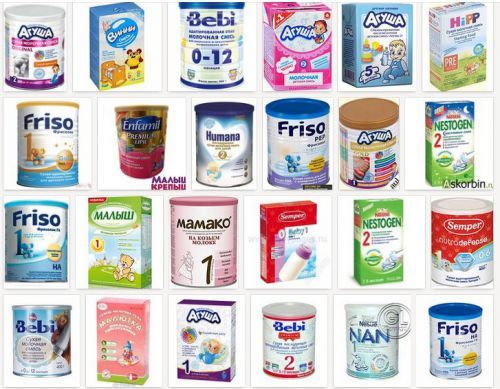 In general, the composition of infant formula is almost identical. But sometimes the product of one company causes an undesirable reaction in the crumbs, and the product of another company of similar composition completely satisfies its organism. That is why the choice of a mixture is required to be taken seriously and very responsibly.
In general, the composition of infant formula is almost identical. But sometimes the product of one company causes an undesirable reaction in the crumbs, and the product of another company of similar composition completely satisfies its organism. That is why the choice of a mixture is required to be taken seriously and very responsibly.
The packed dry mixture is stored at a temperature of 20-22 ° C, the temperature for storage should be 5-10 ° C lower. In this case, the bank should be put in a dry place and ensure that it was carefully closed. The contents of the container should be used in 2-3 weeks. After this period, it is better to please the cat with the rest, if any, rather than continue to feed the baby.
| Appearance of packaging |
Brand name | Producing country | Assortment of infant formula | The composition of the mixtures | |||
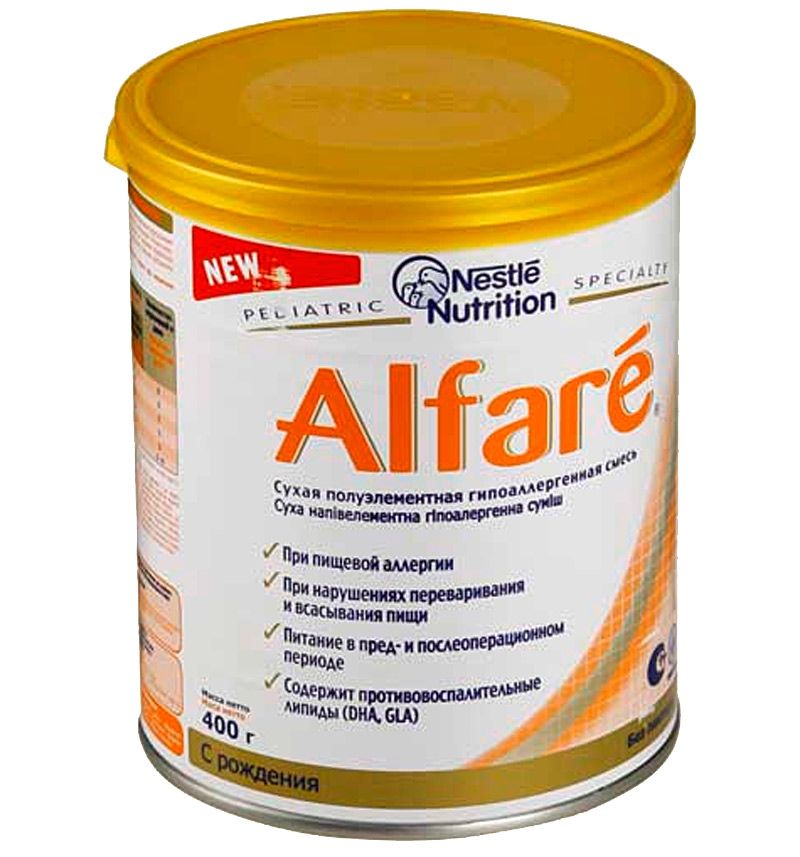 |
Alfare (nestle) (Alphare) |
Netherlands | Alfare Alfare Allergy, Alfare amino Therapeutic hypoallergenic mixtures containing components for restoring damaged mucous membranes, reducing inflammatory processes, improving immunity |
The mixture is enriched with vitamins and mineral salts, fish oil, nucleotides. | |||
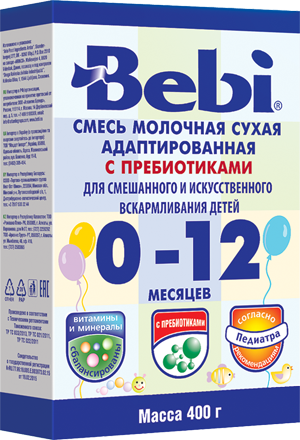 |
Bebi | Slovenia | The manufacturer offers adapted products 1 (0-6 months), 2 levels (6-12 months) and universal (0-12 months), with prebiotics | The composition includes dry milk (skim), lactose, vegetable oils, including palm, soybean and rapeseed. The product is mineralized and fortified |
|||
 |
Bonavi | Czech | The manufacturer offers a mixture of levels 1, 2 and 3 on goat milk. | Among the ingredients are goat milk powder, corn starch, sunflower and rapeseed oil, prebiotics, omega-3 fatty acids, nucleotides, a complex of minerals and vitamins. |
|||
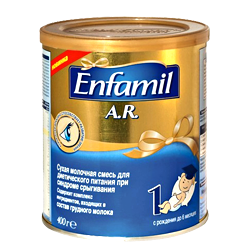 |
Enfamil (Enfamil) |
Netherlands | A wide range of adapted mixtures (including hypoallergenic, low-allergenic and anti-reflux), as well as mixtures of levels 2 and 3, | It contains skimmed milk, vegetable oils (including palm), rice starch, glucose syrup, ARA and DHA acids, and a mineral-vitamin complex. Some, instead of milk, contain only whey protein and skimmed milk protein. |
|||
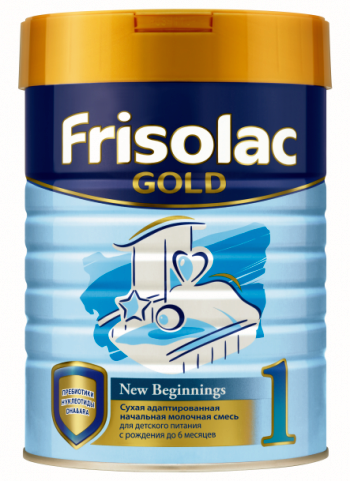 |
Friso (Friso), Frisolac Frisopep Friso soy Friso vom |
Netherlands | A good range of products 1, 2, 3 and 4 (dairy drinks from 3 years). There are hypoallergenic, medicinal, soy protein and night formula | Milk whey (demineralized), vegetable oils, incl. rapeseed and palm, skimmed milk powder. Contains fish oil, minerals and vitamins. The composition of therapeutic and hypoallergenic milk is not included. Some contain glucose syrup, prebiotics, nucleotides |
|||
 |
Hipp (Hipp) | Germany | A small selection of formula 1 - 3 | Organic skimmed milk, whey partially demineralized, vegetable oils, vitamin-mineral complex, etc. Some species contain prebiotics (lactobacillus lactic acid) |
|||
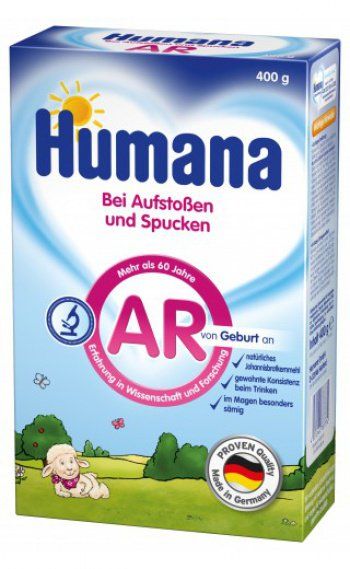 |
Humana | Germany | Large selection of multi-level and therapeutic mixtures. In assortment - for premature babies, with prebiotics, dairy-free, anti-reflux, anti-colic, hypoallergenic, liquid | In the composition there is skimmed cow's milk (in some it is replaced by milk protein hydrolyzate / soy protein lactose / isolate), different types of polysacchides, a mixture of fats including rapeseed and palm oil. Saturated with mineral and vitamin complex |
|||
 |
Karbita | Holland | Three types of mixes on goat milk - 1, 2, 3 levels - in different volumes - 400 and 800 grams | The components include lactose, concentrated whey proteins of goat milk, whole milk powder, a complex of vegetable fats (including palmitiol triglyceride), sugars, corn starch. There is fish oil, vitamins and minerals, bifidobacteria |
|||
 |
MD Mil | Belgium | Four products on goat milk - Goat 1, 2, 3 and Standard | Goat milk, partially skimmed, oils, among which is palm, vitamins, minerals, etc. |
|||
 |
Milupa | Poland | In assortment - 5 types of milk mixtures for different ages, packing - 350 and 600 g | Whey and skimmed milk, vegetable oils - rapeseed, palm, sunflower, coconut, sugars, 13 minerals and 13 vitamins, fish oil, other additives |
|||
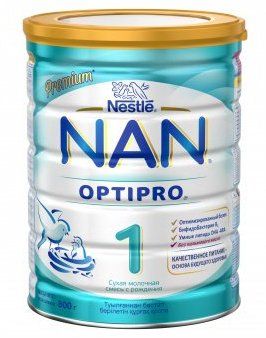 |
NAN (Nestle) | Netherlands | A good choice of mixtures of different generations: anti-colic, lactose-free, hypoallergenic, for premature babies, against colic, regurgitation and constipation, sour-milk |
Whey and lactose, skimmed milk / whey protein / lactose only / only whey powder, vegetable oils (including palm olein), mineral-vitamin complex, etc. |
|||
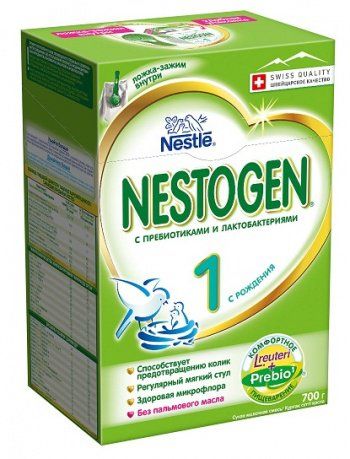 |
Nestogen (Nestle) |
Switzerland | Milk formula 1 - 4 generations, packaging 350 and 700 grams | It contains lactose, skim milk, vegetable oils, prebiotics, milk fat, sugars, vitamin and mineral complexes |
|||
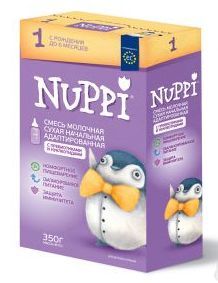 |
Nuppi | Three types of mixes - 1, 2 and 3 levels | The basis of the product is skimmed milk powder, oils of vegetable origin, including palm, calcium carbonate, vitamin premix, mineral compounds |
||||
 |
Nutrilak | Russia | Large assortment of infant formula: for premature babies, anti-reflux, hypo-allergenic, dairy, lactose-free and soy | The basis is dairy sugar and fat / whey and whole dry and skimmed milk / soy protein and glucose syrup / milk fat and protein, vegetable oils (DOES NOT CONTAIN PALM!), Corn starch, sugars, mineral salts, fish oil, vitamins. Depending on the species may contain lactic acid bacteria, bifidobacteria |
|||
 |
Nutrilon (Nutricia) | Poland, Netherlands, | Large selection of mixtures for healthy, premature babies with allergies and digestive problems. Packages 400, 600, 800, 1000 g |
Milk whey, lactose, skimmed milk, sugars, vitamins, fish oil, minerals, etc. | |||
 |
Semper (Semper) |
Sweden | Milk formula for healthy children and for children with impaired digestion | Among the components are skimmed milk, lactose, cream, vegetable oils (including palm oil), mineral compounds, fish oil, vitamins. There are mixtures with bifidobacteria |
|||
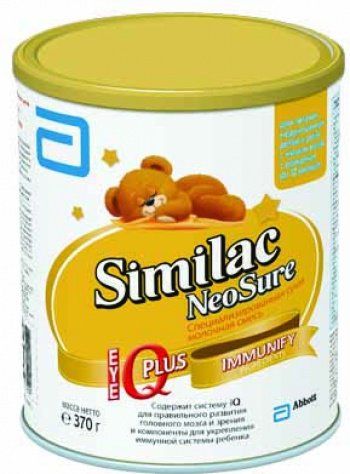 |
Similac (Similac) |
Ireland, Spain | A large range of dry milk formulas for healthy and therapeutic children (hypoallergenic, antireflux, for low-weight and premature babies, low-lactose, lactose-free (based on soy protein)) Packages - 900, 700, 400, 375, 350 g |
The main components of the base mixes are skimmed milk, lactose, vegetable oils (DOES NOT CONTAIN PALM), concentrated whey protein, saccharides, mineral compounds, ARA-acid, vitamins, bifidobacteria | |||
 |
Valio baby | Finland | Three types of infant formula: 0-6, 6-12 and 12+ | The mixture does not contain palm oil! The main components are milk whey, normalized milk, vegetable oils, lactose, sugars, vitamins, minerals, probiotics, etc. |
|||
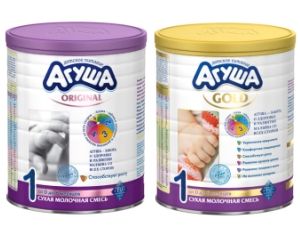 |
Agusha | Russia | Dry and liquid milk and dairy mixes up to 6 and up to 12 months | The basis of dry mixes "Original" is skimmed milk, vegetable oils (palm, too), whey concentrated protein, lactose, citric acid as a preservative, minerals, a complex of vitamins. "Gold" supplemented with prebiotics. Liquid mixtures (fermented milk) contain nucleotides, probiotics, bifidoacidophilus leaven, whole milk, water, cream, a mixture of vegetable oils (among them rapeseed and palm), whey protein concentrate, and vitamin-mineral premix. |
|||
 |
Amalthea (Bibicol) | New Zealand | "Amalthea" - dry goat milk TM "Bibikol" | The product is not an adapted substitute for breast milk, it is recommended from 3 years. It contains only dry goat milk, iron and vitamins. |
|||
 |
Grandma's basket |
Russia | Adapted mixes for healthy babies, antireflux and lactose free |
Milk whey, a mixture of vegetable oils (contains palm), skimmed milk powder, sugars, lactose, minerals, fish oil, vitamins, etc. |
|||
 |
Bellakt | Belarus | A wide range of dairy and dairy-free formulas for feeding healthy babies, incl. and prophylactic purposes (fermented milk, with bifidobacteria), therapeutic mixtures (soy, low-lactose, lactose-free, anti-reflux, for premature babies) |
Skim milk, milk sugar, whey proteins, concentrated, vegetable oils (contains palm olein), vitamins, mineral salts, etc. In therapeutic and prophylactic mixtures, the milk component changes. |
|||
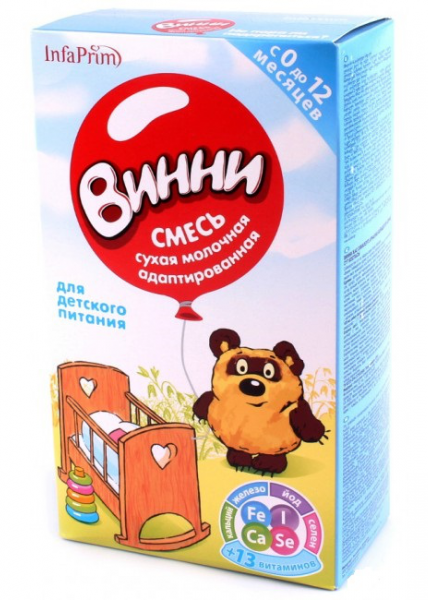 |
Winnie | Russia | Universal feed mixes from 0 to 12 months | Dry whey, a mixture of oils (including palm), skimmed milk powder, minerals and vitamins |
|||
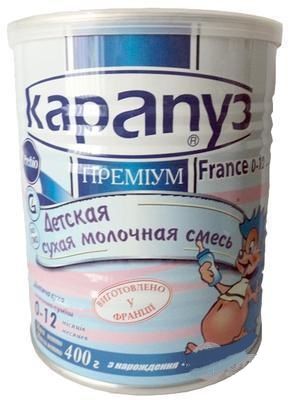 |
Peanut | France | Dairy and sour milk dry mix from 0 to 12 months. | Demineralized whey, a complex of vegetable oils (palm also leads to the composition), dry skimmed milk, saccharides, lactose, vitamins, minerals, etc. |
|||
 |
Kid (Nutricia) | Russia | A small line of mixes for basic nutrition (0-6), with cereal flour to expand the diet (6-12) and baby milk (after a year) | Milk whey, vegetable oils (mixture, including palm), skimmed milk, prebiotics, concentrated whey proteins, mineral compounds, fish oil, vitamins, etc. | Ukraine | The line of mixes is presented by three types of food for children with poor weight in weight, from 3 months: with rice, buckwheat and oatmeal |
Whole cow milk, rice flour, powdered sugar, vegetable oils. Enriched with vitamins and minerals. WITHOUT PALM OIL |
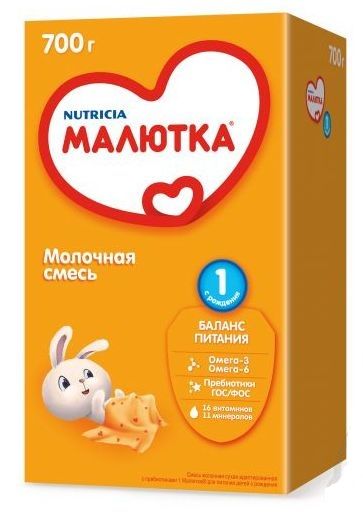 |
Baby (Nutricia) | Russia | A small line of milk and dairy mixes from 0, from 6, from 12 and from 18 months | Demineralized milk whey, a mixture of 5 vegetable oils, skimmed milk, prebiotics, whey protein concentrate, lactose, a complex of micro- and macronutrients, vitamins, fish oil. The composition of fermented milk supplemented with ferment lactic acid and bifidobacteria DOES NOT CONTAIN PALM OIL |
|||
 |
Baby Khorol | Ukraine | The manufacturer produces only three mixtures: 0-6, 6-12 and 12+ months | Cow's milk (fat and sugar normalized), milk sugar, syrup, vegetable oil. Enriched with vitamins and minerals PALM OIL IS NOT INCLUDED |
|||
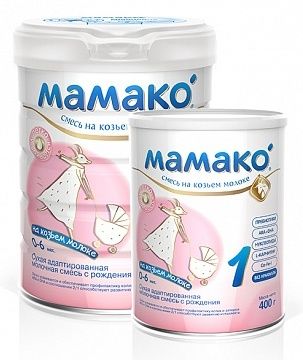 |
Mamako | Serbia | The manufacturer offers three levels of mixes per pack of 400 and 800 grams. | Demineralized goat serum, vegetable oils (palm and palm kernel are also included), lactose, skim goat milk, mineral salts, ARA and DHA acids, prebiotics and vitamins |
|||
 |
Materna | Israel | The manufacturer produces 8 formulas of mixtures: classical, with a high content of nutrients, anti-regurgitation, without lactose, for children with low weight, for healthy sleep, soy-based and kosher blends. 0-6 months, 6-12, 12+, 2+ |
Casein, whey protein concentrate, mineral compounds, fat component, β-palmitate, omega-3 and omega-6, vitamins C and E. The composition of therapeutic mixtures is different. |
|||
 |
Nanny (bibicol) | New Zealand | Classic mix in assortment, with prebiotics and after year | The main components are dry goat milk (whole), whey protein (not less than 20%), fat of vegetable and animal origin, represented by saturated and unsaturated fatty acids, lactose, minerals and vitamins. WITHOUT PALM OIL |
|||
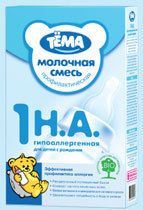 |
Theme | Russia | Several formula milk formula: classic. hypoallergenic |
Lactose, vegetable oils, starch, whey proteins, glucose syrup, vitamins, mineral compounds |
What is silent advertising?
From a variety of dairy mixes in the children's department of the supermarket, eyes scatter. Some promise to relieve the baby of colic forever, and parents from sleepless nights, others guarantee hypoallergenicity, others insist that the crumbs will fill the intestines with the most useful bifidobacteria ... The truth is that the breast milk substitutes on the market have approximately the same composition and quality level, and the secret next. Whey serving as the basic component of any milk mixtures, on the whole Globe produces only two (!) Plants. One is in Europe, the second is in the USA. Therefore, the manufacturer's stories about the unique bio-qualities of the product are just a marketing ploy.
Whey serving as the basic component of any milk mixtures, on the whole Globe produces only two (!) Plants. One is in Europe, the second is in the USA. Therefore, the manufacturer's stories about the unique bio-qualities of the product are just a marketing ploy.
Also, moms should know that buying a domestic mixture is safer. If the production of "relatives" is monitored from the moment of procurement of raw materials to the wholesale, then the import batches certify selectively, and the quality control of all products is not carried out.